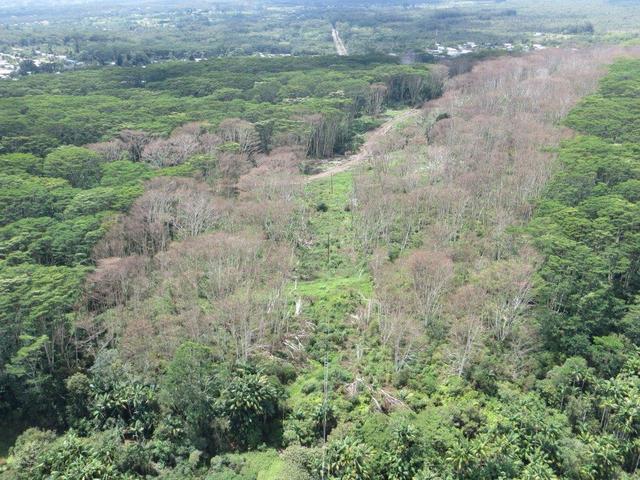A mile-long, 60-acre swath of invasive albizia trees threatening power lines in Piihonua has been eradicated just in time for the start of hurricane season.
A mile-long, 60-acre swath of invasive albizia trees threatening power lines in Piihonua has been eradicated just in time for the start of hurricane season.
“Tropical Storm Iselle demonstrated for everyone what the residents of Puna have known for decades — albizia trees blow down during windstorms, and powerlines take a beating,” Springer Kaye, project manager of the Big Island Invasive Species Committee, said in an email.
Working alongside arborists contracted by Hawaii Electric Light Co., a team from BIISC created a 300-foot- wide buffer zone on either side of the high-power transmission lines, which supply electricity to a large portion of the North Hilo and Hamakua districts.
Bill Buckley, albizia coordinator for the invasive species committee, said in a statement that the effort is a first milestone in the hazard mitigation plan to reduce the threat of albizia across East Hawaii.
“This was all sugar cane into the 1990s, but now some of these trees are 200 feet tall, with massive trunks you can’t wrap your arms around,” Buckley said of the infestation.
The six-week project, the first the invasive species committee has completed partnering with the utility, included the removal or treatment of more than 14,000 albizia trees.
Kaye said all trees within striking distance of the transmission lines were destroyed.
“Before Iselle, the Piihonua line was hidden under a solid canopy of albizia,” she said. “After Iselle, it was buried under that canopy. Clearing the brittle trees from primary transmission lines is first priority, because they feed the smaller residential lines, and are the most expensive lines to repair.”
In addition to the $225,000 spent by HELCO on hazard tree removal, the invasive species committee received approximately $22,500 in grants from the U.S. Forest Service and Hawaii Invasive Species Council.
The expected result, Kaye said, is that instead of re-trimming trees from a narrow easement every six months, HELCO will not have to go in for up to seven years.
Albizia can grow up to an inch in height per day and are notoriously unstable in high wind.
In Puna, Buckley’s team has treated an additional 16,000 trees on 200 acres in the Black Sands subdivision.
Buckley said trees are treated with small amounts of Milestone, an herbicide manufactured by Dow AgroSciences, using an incision-point-injection method. Within two weeks, he said, significant defoliation occurs. And slowly the tree begins to crumble away.
The albizia problem took center stage following Tropical Storm Iselle. In response to the significant damage, legislators introduced nine bills, including companion bills seeking $2.1 million for the management of albizia on Hawaii Island. While that measure failed, the Legislature allocated $1.5 million to the Department of Transportation to address the albizia threat along state highways in 2016.
The site at Piihonua was identified as one of 15 critical mitigation projects along primary transmission lines, state highways and county roads.
On Saturday, the invasive species committee will host a community training workshop in Leilani Estates to teach volunteers to mitigate future hazards by eliminating the fast-growing young trees. Workshops will also be held June 20 in Nanawale Estates and Hawaiian Paradise Park.
For more informaiton, visit www.biisc.org.


